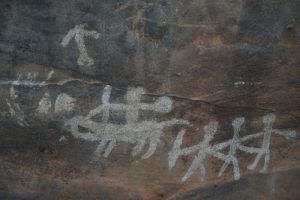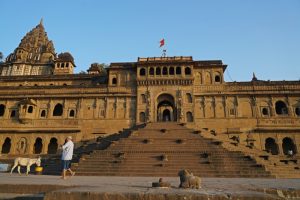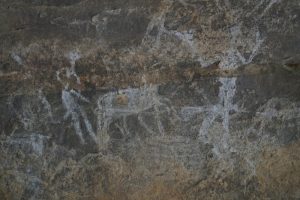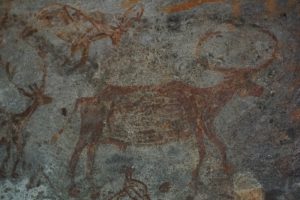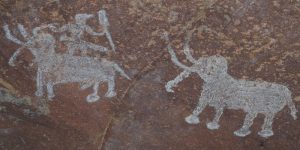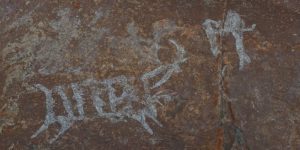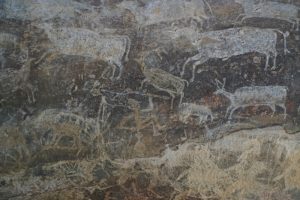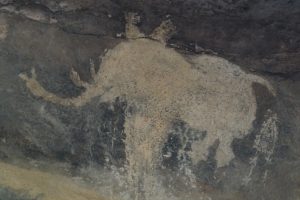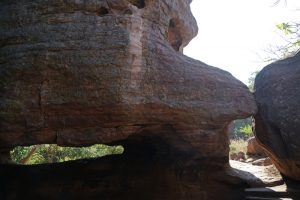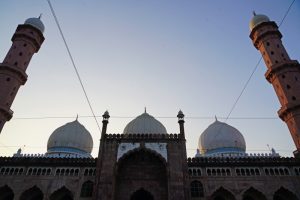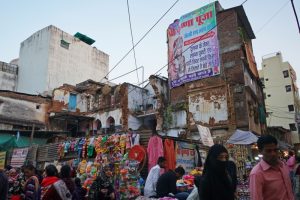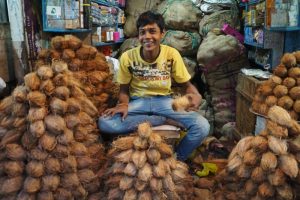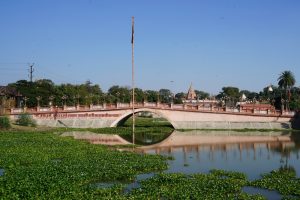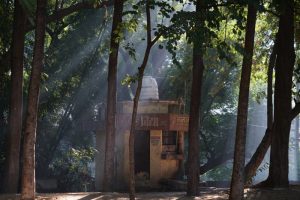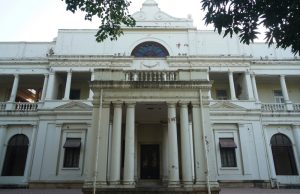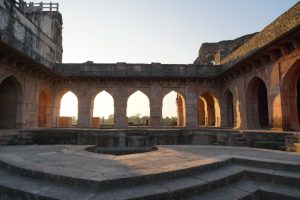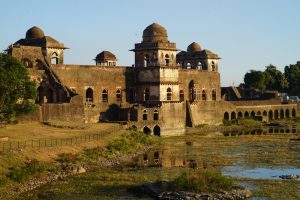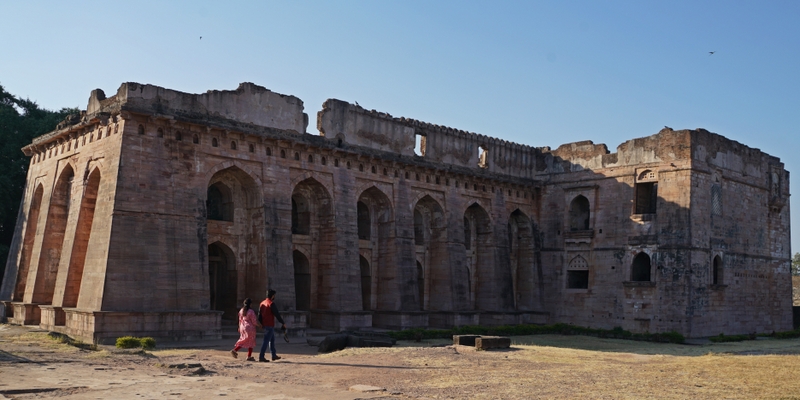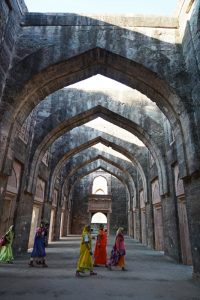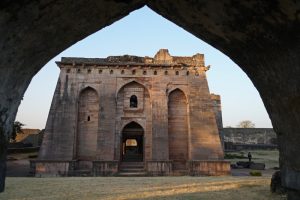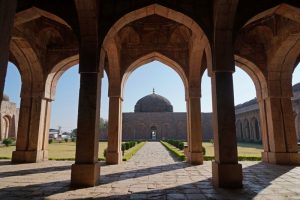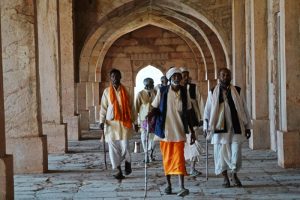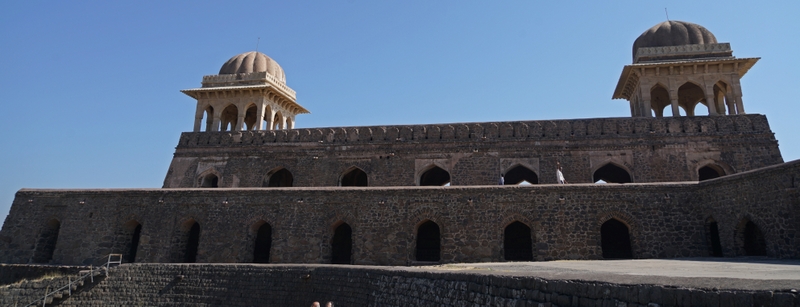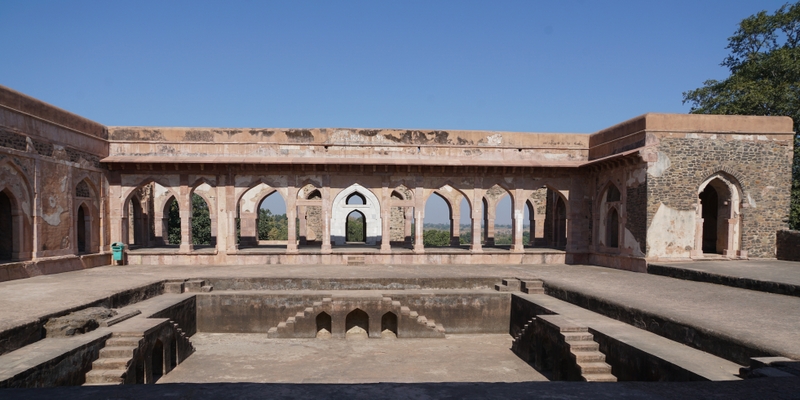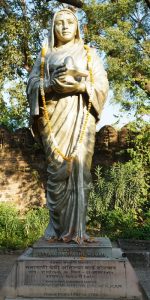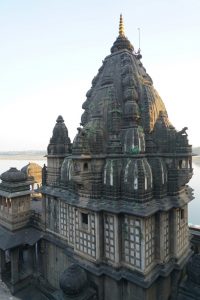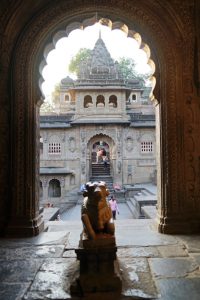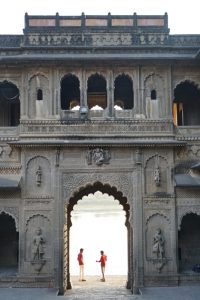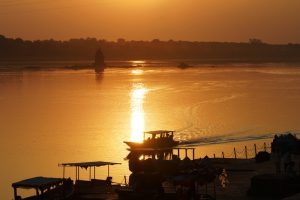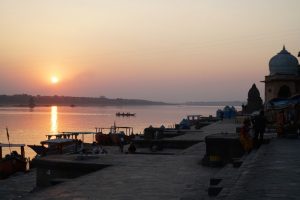November 25 – 28: Bhopal, Bhimbetka, Ujjian, Indore, Dhar, Mandu & Maheshwar
Day 8 November 25 Saturday: Bhopal – Bhimbetka 45km – Bhojpur 25km– Bhopal 28km (about 100km)
We had a relaxing day for the first time and had a wonderful buffet breakfast at the hotel. We took an hour to reach the Bhimbetka Rock Shelters, a World Heritage Site boasting some of the world’s oldest rock paintings dating as far back as 30,000 years.
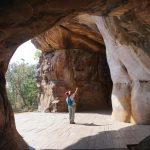
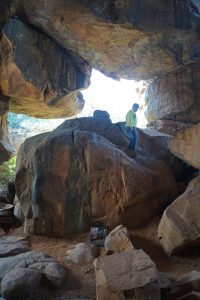
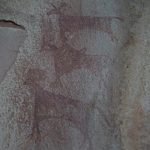 Located in the foothills of the Vindhya range of hills in MP, the rock shelters spread in sandstone formation extending over an area of 1893 ha with a buffer zone 10,280 hectares. Discovered in 1957, the complex comprises a group of “five clusters of rock shelters” with paintings that are inferred to date from the “Mesolithic period right through to the Historical period” with the 21 villages surrounding them reflecting the traditions displayed in the rock paintings.
Located in the foothills of the Vindhya range of hills in MP, the rock shelters spread in sandstone formation extending over an area of 1893 ha with a buffer zone 10,280 hectares. Discovered in 1957, the complex comprises a group of “five clusters of rock shelters” with paintings that are inferred to date from the “Mesolithic period right through to the Historical period” with the 21 villages surrounding them reflecting the traditions displayed in the rock paintings.
The rock art has been discovered in 400 painted shelters spread over an area of 1892 ha amidst dense forest with high diversity flora and fauna with some of the shelters dated from 100,000BC to 1000 AD. As described in the UNESCO inscription, the site complex has “a magnificent repository of rock paintings within natural rock shelters” and is “a unique cultural property representing a convergence displayed in the art form between the people and the landscape with links to the hunting gathering economy of the past”.
The site is well-managed with a boardwalk of about 200-metre long guiding visitors to see 15 spots. The colours used are vegetable colours. The area is arid and some of the paintings are still in good conditions. The drawings and paintings can be classified under seven different periods.
Period 1(Upper Paleolithic) – These are linear representations, in green and dark red, of huge figures of animals such as bison, tigers and rhinoceroses.
Period 2(Mesolithic) – The subject-matters are more complex: there are human figures, weapons used, hunting scenes, dancing, drinking etc
Period III (Chalcolithic): Drawings reveal that during this period the cave dwellers were in contact with the agricultural communities of the Malwa plains and exchanged goods with them.
Period IV and V (Early historic): The figures of this group have a schematic and decorative style and painted mainly in red, white and yellow. The religious beliefs are represented by figures of yakshas, tree gods and magical sky chariots.
Period VIand VII (Medieval): These paintings are geometric linear and more schematic but they show degeneration and crudeness in their artistic style. The “Zoo Rock” is an example of this period.
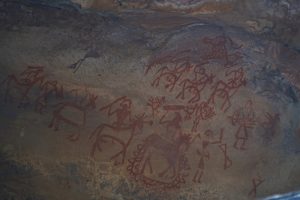 The rock art and paintings here are the best of their kind I have ever seen. Of course, I have yet to see similar but older paintings in Cave of Altamira and Paleolithic Cave Art Northern Spain and the Grotte Ghauvet-Pont d’Arc in France, both are also World Heritage Sites.
The rock art and paintings here are the best of their kind I have ever seen. Of course, I have yet to see similar but older paintings in Cave of Altamira and Paleolithic Cave Art Northern Spain and the Grotte Ghauvet-Pont d’Arc in France, both are also World Heritage Sites.
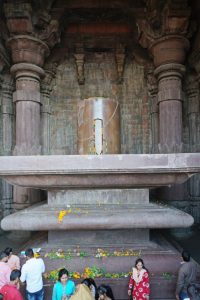 At 12:30pm, we had lunch before driving to Bhojpur to see the incomplete but awesome Bhojeshwar Temple dedicated to Shiva. Construction of the temple is believed to begin in the 11th century during the reign of the Paramara king Bhoja. The reason for abandoning the project is unknown. But the architectural plans engraved on the surrounding rocks have helped scholars understand the temple construction techniques of the time in India.
At 12:30pm, we had lunch before driving to Bhojpur to see the incomplete but awesome Bhojeshwar Temple dedicated to Shiva. Construction of the temple is believed to begin in the 11th century during the reign of the Paramara king Bhoja. The reason for abandoning the project is unknown. But the architectural plans engraved on the surrounding rocks have helped scholars understand the temple construction techniques of the time in India.
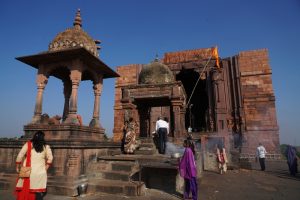 The temple made of large sandstone blocks, lies on a platform measuring 35 metres long, 25 metres wide and 4 metre high. The imposing temple/sanctum comprising a square (20 metre on each side), though incomplete, has a richly carved dome which is supported by four octagonal pillars (each 12.18 metre high). The four brackets supporting the cornerstones feature four divine couples: Shiva-Parvati, Brahma-Shakti, Rama-Sita and Vishnu-Lakshmi. Inside the sanctum is a 2.3-metre high siva-linga which would be 12 metres in height including the platform.
The temple made of large sandstone blocks, lies on a platform measuring 35 metres long, 25 metres wide and 4 metre high. The imposing temple/sanctum comprising a square (20 metre on each side), though incomplete, has a richly carved dome which is supported by four octagonal pillars (each 12.18 metre high). The four brackets supporting the cornerstones feature four divine couples: Shiva-Parvati, Brahma-Shakti, Rama-Sita and Vishnu-Lakshmi. Inside the sanctum is a 2.3-metre high siva-linga which would be 12 metres in height including the platform. 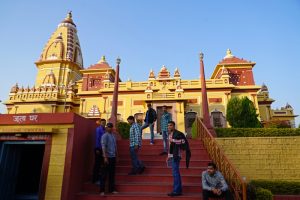
We returned to Bhopal and visited a temple and a mosque.
- The Lakshmi Narayan Temple (photo on the right). Situated at the highest point of Bhopal and built by the Birala Family, this new temple is dedicated to Lakshmi and her husband Vishnu and houses a beautiful shrine of Shiva with his wife Parvati.
- The Taj-ul-Masajid, the largest mosque in India (photo on the left). Construction of the mosque was initiated during the reign of the Mughal Emperor Bahadur Shah Zafar and began by Nawab Shah Jahan Begum of Bhopal whose reign began in 1844. Construction stopped after1857 owing to lack of funds. Construction resumed in 1971 and completed in 1985.
We were thrilled when Mukesh took us to see the market next to the mosque. I always love local markets where I can see and mix with the locals, see the colours and feel the pulse and culture of the place. There are hundreds of shops and vendors selling jewellery, clothes, saris, food, sweets, tea, spices etc. We bought a lot of spices from a local store.
Indians eat late and the hotel restaurant opens at 8pm. At our request, the restaurant opened specially for us. Siu Mui and I had chicken biryani while Flora and Bing had fish and mutton curry. We were the only guests and had three staff serving food and drinks and four musicians singing for us. We paid 2800 rupees for an excellent meal and superb service! What a treat!
Day 9 November 26 Sunday: Bhopal – Ujjain 192km – Indore 56km
We had breakfast on the lawn overlooking the Upper Lake. It’s peaceful and lovely. We set off at 8:45am after paying a total of 7134 rupees for two dinners for four in the hotel. Excellent value! The highway to Ujjain is well-paved and we arrived in the city at noon.
Considered one of the holiest cities in India and a popular pilgrimage place for Shaivites, Vaishnavites and followers of Shakta Hindus, pilgrims and devotees flock to the Mahakaleshwar Temple situated on the side of the Rudra Sagar Lake. The temple has five levels, one of which is underground, and topped with a soaring shikhar (the spire) adorned with sculptural finery. It is a beautiful and artistic amalgamation of Maratha, Bhumija and Chalukya styles of architecture.
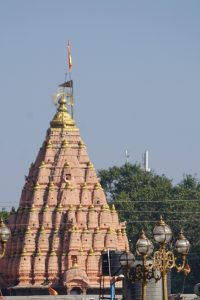 Mahakaleshwar Jyotirlinga located in the sanctum below the ground level is the most important and sacred Jyotirlingamsms amongst the twelve sacred Jyotirlingamsms. Here Lord Shiva in the lingam form is believed to be Swayambhu deriving power (Shakti) from within itself as against the other images and lingams that are ritually established. The idol of Mahakaleshwar is known to be dakshinamurti, which means that it is facing the south. This is a unique feature found only in Mahakaleshwar among the 12 Jyotirlingas.
Mahakaleshwar Jyotirlinga located in the sanctum below the ground level is the most important and sacred Jyotirlingamsms amongst the twelve sacred Jyotirlingamsms. Here Lord Shiva in the lingam form is believed to be Swayambhu deriving power (Shakti) from within itself as against the other images and lingams that are ritually established. The idol of Mahakaleshwar is known to be dakshinamurti, which means that it is facing the south. This is a unique feature found only in Mahakaleshwar among the 12 Jyotirlingas. 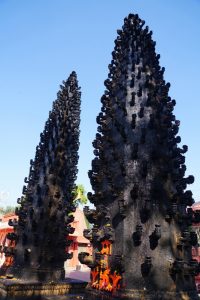
The idol of Omkareshwar Mahedvi is consecrated in the sanctun above the Mahakal shrine. The images of Ganesh, Parvati and Kartikeya are installed in the west, north and east of the sanctum sanctorum. The idol of Nagchandreshwar on the third storey is open for darshan only on the day of Nag Panchami. A large Kunda is the compound is considered celestial. The complex was destroyed in 1234-5 and the present structure was built in 1736 with further developments thereafter.
Ujjian is famous for celebrations at the temple. The main festivals celebrated here are Nitya Yatra where devotees take a bath in the holy Sipra before visiting a number of temples and Sawari, the sacred rocession of the Almighty passing through the streets of Ujjain on every Monday for some particular periods.
Ujjian is also the location for another spectacular event – Simhasth Kumbh Mahaparv which is one of the four Kumbh Melas and alrgest spiritual gathering in India. Thousands of sandhus descend in the city to take a holy dip on the banks of river Kshipra. The event is based on the celestial line up of the planets and signs of Zodiac which occurs in every 12 years. The last one took place last year.
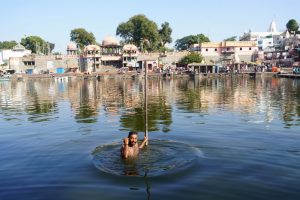 We queued for about 15 minutes before entering the Mahakal shrine below ground. The devotees were emotive chanting and praying aloud. The air was stuffy and the thought of stampede scared me. But no one is allowed to step outside the rail to approach the image: all visitors can only view it from a distance and on a TV screen. Mukesh took us to see the second storey at ground level with impressive carved pillars and images of Omkareshwar Mahedvi, Ganesh, Parvati and Kartikeya. In the middle of the compound is an old sacred banyan tree, the national tree of India.
We queued for about 15 minutes before entering the Mahakal shrine below ground. The devotees were emotive chanting and praying aloud. The air was stuffy and the thought of stampede scared me. But no one is allowed to step outside the rail to approach the image: all visitors can only view it from a distance and on a TV screen. Mukesh took us to see the second storey at ground level with impressive carved pillars and images of Omkareshwar Mahedvi, Ganesh, Parvati and Kartikeya. In the middle of the compound is an old sacred banyan tree, the national tree of India.
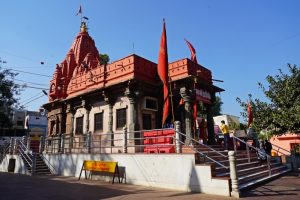 We visited the Harsiddhi Temple before heading to River Kshipra where we watched locals taking a dip by the ghats.
We visited the Harsiddhi Temple before heading to River Kshipra where we watched locals taking a dip by the ghats.
We had a nice lunch enroute to Indore. This time we had the chicken handi(a whole chicken for 390 rupees). The meat is tender andjuicywhile the curry is spicy but not hot. An excellent meal!
Indore
Indore lying on the banks of the rivers Sarawati and Khan and between the Deccan and Delhi was a trading hub in the 16th century. The history of Indore is inseparable from the history of the Holkar State. Malhar Rao Holkar born in 1693 found the House of Holkars and was given the territories by the Peshwa. His capable daughter-in-law Rani Ahilya became the queen when her son died and built up the city promoting prosperity of the region and its people. Indore became the State capital in 1811 and retained this role till 1948. Today, Indore remains MP’s largest city and commerical centre. 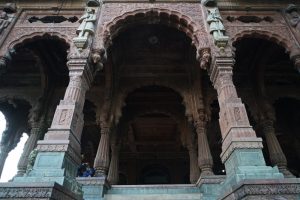
We arrived in the city at 5pm. Our first stop was the Khajrana and Gomatgiri Tombs of Holkar.
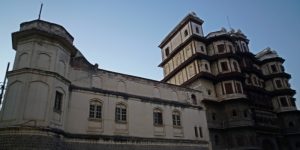 Next, we rushed through the old town to the Kanch Maandir, a Jain temple . Unfortunately it was closed as it was 5:30pm. Mukesh paid 100 rupees and the attendant let us in for 10 minutes. The temple is part of a former white marble palace. The inside of the temple is entirley inlaid with glass. Atop is a special glass chamber which multiplies the three statutes of Lord Mahavira installed there into an indefinite number (said to be visible upto 21 times, corresponding to the 21 tirthankaras).
Next, we rushed through the old town to the Kanch Maandir, a Jain temple . Unfortunately it was closed as it was 5:30pm. Mukesh paid 100 rupees and the attendant let us in for 10 minutes. The temple is part of a former white marble palace. The inside of the temple is entirley inlaid with glass. Atop is a special glass chamber which multiplies the three statutes of Lord Mahavira installed there into an indefinite number (said to be visible upto 21 times, corresponding to the 21 tirthankaras). 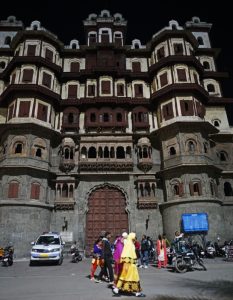
The most interesting and enjoying part was the stroll through the old market to get back to the minibus. Most most of the shops were closed on Sunday, I was still amazed by lights, noises, smell and movements of people and vehicles.
We checked in Lemon Tree Hotel which is new. As we were not hungry, we skipped dinner and spent an hour wandering around the neighbourhood. The new up-market commercial centre opposite the hotel is not fully occupied. But the H&M (a Swedish fashion shop) located on two floors is a sign of prosperity of the city!
Day 10 November 27 Monday: Indore – Dhar 64km – Mandu 35km
We visited two main attractions in Indore before leaving for Dhar.
Lal Bagh Palace. It is one of the grandest monuments the Holkar dynasty left in Indore. Construction began in 1886 and finally completed in 1921, the palace with a total area of 28 hectares had held many royal receptions.
Khajrana Ganesh Temple (1875). It houses the largest Ganesh idol in the world measuring 25ft from crown to foot.
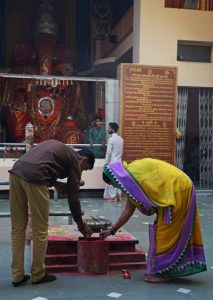
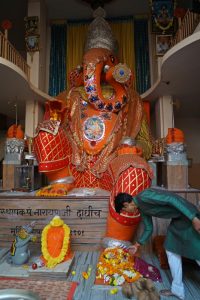
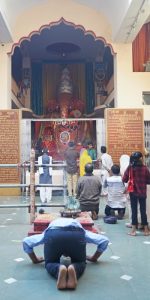 In Dhar, a small city which had once been the state capital, we visited two mosques.
In Dhar, a small city which had once been the state capital, we visited two mosques.
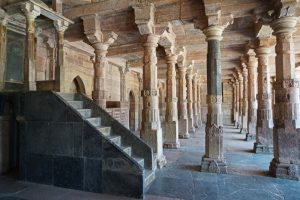
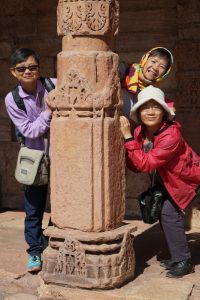 Bhoj Shala meaning ‘Hall of Bhoja’, is the site of the early 11th century centre for Sanskrit studies and temple of Saraswati- the Hindu goddess of learning, music and arts. It is attributed to King Bhoja of the Paramara Dynasty who reigned c.1010-1055 AD and was a patron of education and arts and the author of several works on grammar and poetics.
Bhoj Shala meaning ‘Hall of Bhoja’, is the site of the early 11th century centre for Sanskrit studies and temple of Saraswati- the Hindu goddess of learning, music and arts. It is attributed to King Bhoja of the Paramara Dynasty who reigned c.1010-1055 AD and was a patron of education and arts and the author of several works on grammar and poetics.
The site has evidently been in association with Hinduism and Jainism and later on Islam. The main huge dome is a Hindu architecture while there are tombs and traces of an ancient mosque nearby. Hence, the site has been disputed between Hindus and Muslims. Arrangements have therefore been made for Muslims to pray on Friday and Islamic festivals and for Hindus on Tuesday and the festival for goddess Saraswati. It is open to visitors for the rest of the week.
The place was empty. I like its simple but somewhat elegant architecture style. There are a mihrab, a throne and a minbar in the hall which is supported by slender sandstone pillars with carvings. My friends and Mukesh had fun taking photos on the throne and the minbar.
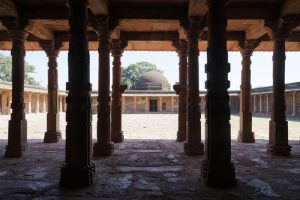
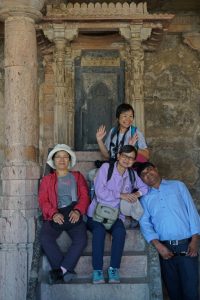 We drove a short distance to Lath Masjid (also known as ‘Pillar Mosque’). Built in 1405 by Dilawar Khan, it derives its name from a pillar made of iron which is supposed to have been set up in the 11th century. The 13-metre high pillar is fallen and broken and the three surviving parts are displayed on a small platform outside the mosque. It carries a later inscription recording a visit of the Mughal Emperor Akbar in 1598.
We drove a short distance to Lath Masjid (also known as ‘Pillar Mosque’). Built in 1405 by Dilawar Khan, it derives its name from a pillar made of iron which is supposed to have been set up in the 11th century. The 13-metre high pillar is fallen and broken and the three surviving parts are displayed on a small platform outside the mosque. It carries a later inscription recording a visit of the Mughal Emperor Akbar in 1598.
We bought some fresh vegetables from the market as we would have home cooking by Mukesh and Dhiraj, our Mandu guide (500 rupees pp). We stopped for a light lunch at Hotel Fun n Food (1000 rupees for four of us).
Mandu, an ancient city 35km from the Dhar city, is today adorned with spell-binding Afghan architecture surrounded by baobab trees, native to Africa. Situated at an elevation of 633 metres and perching on the Vindhya Range extending for 13km while overlooking the plateau of Malwa to the north and the valley of the Narmada River to the south, Mandu had a strategic position and acted as natural defenses.
It gained prominence in 10th and 11th centuries under the Paramaras who moved the capital from Dhar to Mandu in 1261. in 1305, the Parmaras were captured by the Khijis Dilawar Khan, the Afghan ruler of Malwa and his son Hoshan Shan who reigned from 1405 to 1435, constructed magnificent buildings and structures bringing Mandu to its zenith. The fort-capital with a large number of palaces, mosques, Jain temples and many buildings was once enclosed by a battlemented wall which is nearly 37km and punctuated by 12 gateways.
The Khalji dynasty ended in 1526 when Mandu was temporarily taken over by Bahadur Shah of Gujarat. Mandu become part of the Mughal empire under Emperor Akbar in 1570. But it kept a considerable degree of independence until being taken by Marathas Peshwa Baji Rao I in 1732. The capital of Malwa was then shifted back to Dhar.
We arrived at Jahaz Mahal – ship palace at 2:30pm and spent almost three hours in this expansive ground to see a number of ruins.
Jahaz Mahal built by Sultan Ghiyas-ud-din-Khalji in the second half of the 15th century, is a two-storied structure (110 metres long and 15 metres wide) appearing as a ship floating between two artificial lakes (Munj Talao and Kapur Talao). It served as a harem for the sultan who allegedly had 15,000 women. The main entrance has a recessed arch and is flanked on each side by six arched openings. The ground floor has three large halls. There are a number of pools connected by water channels.
Hindola Mahal meaning ‘Swinging Palace” is so named due to its sloping side walls. Probably constructed in the 15th century, it is one of a set buildings making up the royal palace complex. This simple but majestic palace may have been used as an audience chamber.
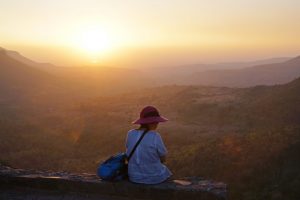 Dhiraj also showed us the underground reservoir system, the water channels, an escape tunnel and a Turkish bath. We had half an hour to stroll around the ruins before departing for the Sunset Point. Sitting on the edge of a cliff, I watched the valleys and mountain ranges below basking in the orange golden sunrays. The sunset was gorgeous, serene and beautiful!
Dhiraj also showed us the underground reservoir system, the water channels, an escape tunnel and a Turkish bath. We had half an hour to stroll around the ruins before departing for the Sunset Point. Sitting on the edge of a cliff, I watched the valleys and mountain ranges below basking in the orange golden sunrays. The sunset was gorgeous, serene and beautiful!
After checking in our rustic hotel, we had a rest before going to Dhiraj’s house for dinner. His French wife and two kids were in Paris and he would join them for Christmas in a fortnight’s time. We had fish and mutton curry, honey peas and lady fingers. The food was light and delicious. We had beer and the boys had whiskey. After dinner, my friends were so high that they started to dance. Raja and Raju also joined in. At 10 pm Raja drove us back to our hotel. The boys did not eat till 10:30 pm. Luckily Indian like the Spanish eat late!
Day 11 November 28 Tuesday: Mandu – Maheshwar 65 km
I like Mandu which is charming, green and relaxing. I had an enjoyable morning sightseeing and shopping. We had a new local guide who took us to Jama Masjid the oldest mosque dating from 1405 and a notable example of Pashtun architecture. Inspired by the great mosque of Damascus, the mosque has a entrance and a large courtyard framed by colonnades.
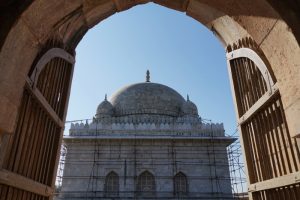
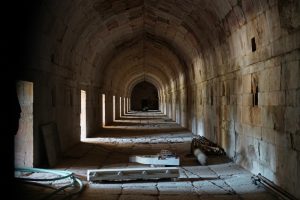 At the doorstep of the mosque is a 6th-century fort complex where the marble mausoleum of Hoshang Shan is located. According to our guide, this beautiful structure gave Shan Jahan the inspiration to build the Taj Mahal two centuries later.
At the doorstep of the mosque is a 6th-century fort complex where the marble mausoleum of Hoshang Shan is located. According to our guide, this beautiful structure gave Shan Jahan the inspiration to build the Taj Mahal two centuries later.
We visited a popular Ram Temple built in 1769 before spending half an hour wandering in the ruins of Asharifi palace just opposite the Jama Masjid. Initially built with the idea of promoting education, this edifice was a school before its builder Mohammed Khalji decided to extend it and make it his palace. But due to incompetent architectural designs, the building soon collapsed.
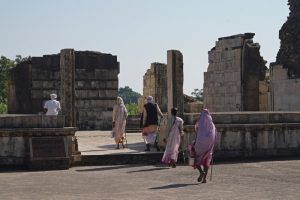
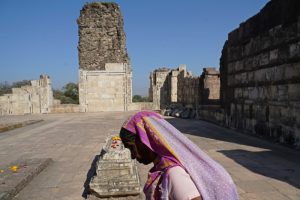 Then the guide took us to visit the Rupumati Pavilion a large sandstone structure on three levels. Originally built as an army observation post, the structure is solid with stables for horses on the first level. We had fabulous views of the surrounding mountain ranges, lush green Nimar plains, Narmada River and the Bajbhadur Palace below from the pavilion on the top level.
Then the guide took us to visit the Rupumati Pavilion a large sandstone structure on three levels. Originally built as an army observation post, the structure is solid with stables for horses on the first level. We had fabulous views of the surrounding mountain ranges, lush green Nimar plains, Narmada River and the Bajbhadur Palace below from the pavilion on the top level.
We walked downhill to the Bajbhadur Palace built by Baz Bahadur in the 16th century. It is famous for its large courtyards encompassed by large halls with excellent acoustics and high terraces.
Mukesh took us to his friend’s shop where we all bought something for the first time. Siu Mui was the biggest spender and bought many silk scarfs and pashmina.
We had a light lunch in a resort hotel in Mandu for about 1000 rupees and arrived in Maheshwar after 3pm. We first checked in the Narmada Retreat by Narmada River and departed for sightseeing after 4pm.
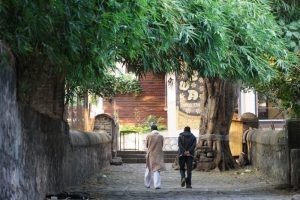 Situated on the banks of river Narmada, Maheshwar was the capital of Malwa during the Maratha Holkar reigns till January 1818 when the capital was moved to Indore by Malhar Rao Holkar III. It is also a centre of hand loom weaving since the 5th century. It produces the exquisite Maheshwar saris and fabric.
Situated on the banks of river Narmada, Maheshwar was the capital of Malwa during the Maratha Holkar reigns till January 1818 when the capital was moved to Indore by Malhar Rao Holkar III. It is also a centre of hand loom weaving since the 5th century. It produces the exquisite Maheshwar saris and fabric.
The history of Maheshwar is interwoven with Rani Ahilyabai (1725-1795) the third ruler of the Holkar dynasty. She was the daughter-in-law of Malhar Rao Holkar who founded the dynasty and became queen of Malwa after the death of her father-in-law in 1766 and her son-king in 1767. A shrewd politician, a competent and caring ruler, a great pioneer and builder, she ruled Malwa till her death with Maheshwar as the capital. The Maheshwar Fort she built is therefore also known as Ahilya Fort and the Queen’s Fort.
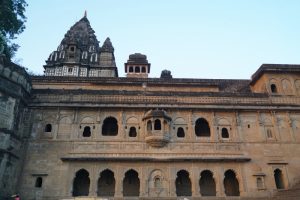 During her reign, Maheshwar was the scene of literary, musical, artistic and industrial enterprise. She built forts and road in Malwa and established a textile industry in Maheshwar, She also built hundreds of temples and Dharmashala throughout India. Indore developed from a small village to a prosperous city.
During her reign, Maheshwar was the scene of literary, musical, artistic and industrial enterprise. She built forts and road in Malwa and established a textile industry in Maheshwar, She also built hundreds of temples and Dharmashala throughout India. Indore developed from a small village to a prosperous city.
We spent almost two hours in the Maheshwar Fort complex. We first went to see the most important and sacred place in the royal palace where the queen prayed to Lord Shiva every morning after having taken a bath in holy river at sunrise. Today, the royal palace proper that can be seen from the river, has been converted into a boutique hotel managed by the son of the last Maharaja of Indore. We also went in a modest building which served as her office and place to receive officials and visitors. Outside is a statute of the queen who was highly respected by her people.
We then walked down the wide stately stairway leading to the river. Half way down, we stopped at the magnificent Ahilyeshwar Temple dedicated to Lord Shiva. It comprises intricate designs and artworks in honour of the deity and also s shrine of Lord Rama.
Outside the imposing fort is the enchanting Narmada Ghat which is dotted with temples. I fall in love with the place which is tranquil, peaceful, elegant and serene. The sun was setting and we took a private boat for 1000 rupees. Unfortunately, the sun soon disappeared below the horizon in less than 15 minutes’ time. But the sky continued to show an amazing range of hues. There were some devotees bathing in the river while many were praying at the temples along the ghat. Atmospheric and spiritual!
I had a great but leisure day. After an early dinner, I went to bed early and had a good sleep.


